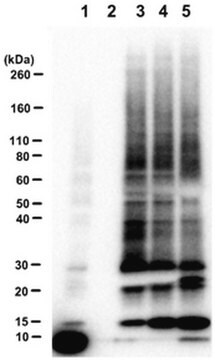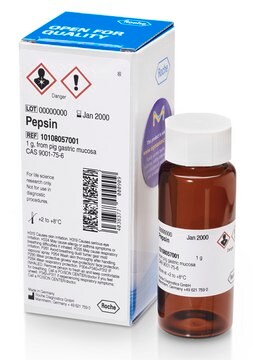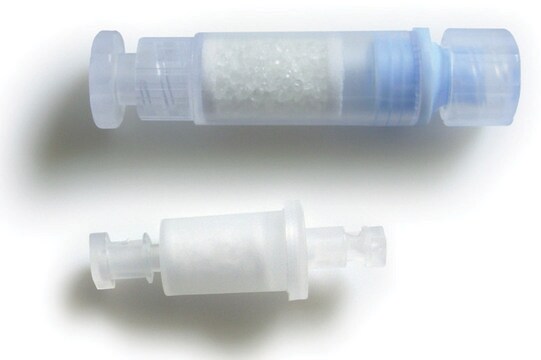662200
Ubiquitinated Protein Enrichment Kit
Zaloguj sięWyświetlanie cen organizacyjnych i kontraktowych
About This Item
Kod UNSPSC:
41116133
Polecane produkty
zastosowanie
kit sufficient for 12.5-25 mg process (lysate)
Poziom jakości
producent / nazwa handlowa
Calbiochem®
warunki przechowywania
do not freeze
temp. przechowywania
2-8°C
Opis ogólny
A rapid method for isolating ubiquitinated proteins using affinity beads comprised of a GST-fusion protein containing an ubiquitin-associated sequence bound to glutathione-agarose. Useful for the enrichment of polyubiquitinated proteins from cell and tissue lysates of a broad range of species including canine, human, mouse, and yeast. The ubiquitinated proteins can be identified by loading the beads directly onto SDS-PAGE and then immunoblotting with the antibody of choice or Anti-Ubiquitin (Cat. No. 662099). Alternatively, it is possible that the beads can be treated with Isopeptidase T (Cat. No. 419700) to release the proteins from the ubiquitin chains.
A vast majority of short-lived proteins are degraded by the ubiquitin-proteasome pathway. A protein marked for degradation is covalently attached to multiple molecules of ubiquitin, a highly conserved 76-amino acid (8.6 kDa) protein, by a multi-enzymatic system consisting of Ubiquitin-activating (E1), Ubiquitin-conjugating (E2), and the Ubiquitin-ligating (E3) enzymes. The E1 activates a Ubiquitin monomer at its C-terminal cysteine residue to a high-energy thiolester bond which is then transferred to a reactive cysteine residue of the E2 enzyme. The final transfer of ubiquitin to e-amino group of a reactive lysine residue of substrate proteins is brought about by the E3 enzyme. Ubiquitinated protein is then escorted to the 26S proteasome where it undergoes final degradation and the ubiquitin is released and recycled. A family of proteins including Rad23, contain two ubiquitin-associated domains that bind ubiquitinated cellular proteins and translocate them to the proteasome. Ubiquitinated proteins can be enriched using affinity beads comprised of a GST-fusion protein containing this ubiquitin-associated sequence conjugated to glutathione-agarose.
Komponenty
Polyubiquitin Affinity Beads, Control Glutathione-Agarose Beads, Control Lysate, and a user protocol.
Ostrzeżenie
Toxicity: Multiple Toxicity Values, refer to MSDS (O)
Przechowywanie i stabilność
Upon arrival store entire contents of the kit at 4°C.
Inne uwagi
Chen, L. and Madura, K. 2002. Mol. Cell Biol. 22, 4902.
Chen, L., et al. 2001. EMBO Rep.2, 933.
Chen, L., et al. 2001. EMBO Rep.2, 933.
Informacje prawne
Sold under license of PCT Application wo 03/049,602.
CALBIOCHEM is a registered trademark of Merck KGaA, Darmstadt, Germany
Ta strona może zawierać tekst przetłumaczony maszynowo.
Hasło ostrzegawcze
Danger
Zwroty wskazujące rodzaj zagrożenia
Zwroty wskazujące środki ostrożności
Klasyfikacja zagrożeń
Acute Tox. 4 Dermal - Aquatic Chronic 3 - Eye Dam. 1 - Repr. 2 - Skin Sens. 1
Kod klasy składowania
10 - Combustible liquids
Certyfikaty analizy (CoA)
Poszukaj Certyfikaty analizy (CoA), wpisując numer partii/serii produktów. Numery serii i partii można znaleźć na etykiecie produktu po słowach „seria” lub „partia”.
Masz już ten produkt?
Dokumenty związane z niedawno zakupionymi produktami zostały zamieszczone w Bibliotece dokumentów.
J Zhu et al.
Oncogene, 33(34), 4340-4351 (2014-01-21)
Estrogen receptor α (ERα) is initially expressed in the majority of breast cancers and promotes estrogen-dependent cancer progression by regulating the transcription of genes linked to cell proliferation. ERα status is of clinical importance, as ERα-positive breast cancers can be
Jian Chen et al.
The American journal of pathology, 175(1), 400-411 (2009-06-17)
Tumor hypoxia directly promotes genomic instability and facilitates cell survival, resulting in tumors with a more aggressive phenotype. The proto-oncogene pim-1 regulates apoptosis and the cell cycle by phosphorylating target proteins. Overexpression of Pim-1 can cause genomic instability and contribute
Christian Ehlting et al.
Scientific reports, 9(1), 11021-11021 (2019-08-01)
The p38MAPK downstream targets MAPKAP kinases (MK) 2 and 3 are critical for the regulation of the macrophage response to LPS. The extents to which these two kinases act cooperatively and distinctly in regulating LPS-induced inflammatory cytokine expression are still
Roi Cal et al.
Arteriosclerosis, thrombosis, and vascular biology, 33(2), 369-377 (2012-12-18)
Low density lipoprotein retention and aggregation in the arterial intima are key processes in atherogenesis. Aggregated LDL (agLDL) is taken up through low-density lipoprotein receptor-related protein 1 (LRP1) by human vascular smooth muscle cells (VSMC). AgLDL increases LRP1 expression, at
Nasz zespół naukowców ma doświadczenie we wszystkich obszarach badań, w tym w naukach przyrodniczych, materiałoznawstwie, syntezie chemicznej, chromatografii, analityce i wielu innych dziedzinach.
Skontaktuj się z zespołem ds. pomocy technicznej









